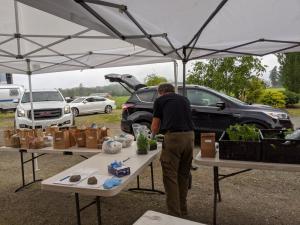2020 - Volume #44, Issue #6, Page #07
[ Sample Stories From This Issue | List of All Stories In This Issue | Print this story
| Read this issue]
Online Farmers Markets Catching On
 |
“It’s similar to an in-person farmers market, but it’s prepay,” says Julie Kintzi, Cart Before Horse Farm near Seattle, Wash. “We’ve had great feedback from customers. Our farmers like it because they know just how much to pick, pack and bring to market.”
The concept was developed in Europe in recent years. REKO stands for rejäl konsumtion in Swedish, or reilua kuluttamista in Finnish. Both mean fair consumption. Scandinavia boasts more than 500 rings, with one in Norway claiming 20,000 members.
REKO Rings really picked up steam in the U.S. after COVID hit. Kintzi produces and sells turkeys, garlic, onion and cilantro at the local farmers market that she helped organize. She became one of the founders of the Enumclaw REKO Market. She notes that one of her fellow area growers suggested setting up a REKO several years ago. Last spring the time was right.
“We dove in because of COVID-19 and not knowing if the markets could or would open,” says Kintzi. “We set it up quickly, covering the basics and learned as we went. We are following farmers market regulations and health codes as much as we can, because there are none for REKO markets.”
The Enumclaw REKO Market kicked off in early May. The Facebook group soon numbered nearly 1,500 members. Under the rules, order taking closes at noon on Friday. Growers take payment in the method they prefer. On Saturday afternoon, vendors and customers meet at a designated site. Unlike a farmers market that can last for 5 to 6 hrs. or more, this is only open for 2 hrs.
“Vendors are present and pass products directly to the customers, who don’t even get out of their cars,” explains Kintzi. “We follow all the COVID guidelines with masks, gloves and social distancing.”
Kintzi says that while there have been no complaints about the new market, grower success with it varied. The most successful growers had consistent product offerings and promoted the market to their customers. Getting the word out on the new market is one of the challenges, she adds.
“Some of our vendors could do this year round, but we need the delivery under cover,” says Kintzi. “One of the positive things is that it’s local. Our growers are all within a 30-mile radius, and our customers are too. It lets me sell more locally. In the past I sold to people in areas farther away.”
Contact: FARM SHOW Followup, Julie Kintzi (julie@cbhfarm.org; https://www.facebook.com/groups/528024898100679/)

Click here to download page story appeared in.

Click here to read entire issue
To read the rest of this story, download this issue below or click here to register with your account number.




